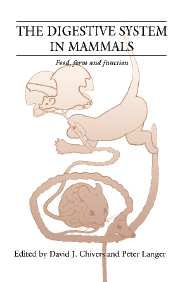Book contents
- Frontmatter
- Contents
- List of contributors
- Preface
- Part I Introduction
- Part II Food
- Part III Form
- Part IV Function
- 18 Foraging and digestion in herbivores
- 19 Gut morphology, body size and digestive performance in rodents
- 20 The integrated processing response in herbivorous small mammals
- 21 Digestive constraints on dietary scope in small and moderately-small mammals: how much do we really understand?
- 22 The effects and costs of allelochemicals for mammalian herbivores: an ecological perspective
- 23 Short-chain fatty acids as a physiological signal from gut microbes
- Part V Synthesis and perspectives
- Index
19 - Gut morphology, body size and digestive performance in rodents
Published online by Cambridge University Press: 18 March 2010
- Frontmatter
- Contents
- List of contributors
- Preface
- Part I Introduction
- Part II Food
- Part III Form
- Part IV Function
- 18 Foraging and digestion in herbivores
- 19 Gut morphology, body size and digestive performance in rodents
- 20 The integrated processing response in herbivorous small mammals
- 21 Digestive constraints on dietary scope in small and moderately-small mammals: how much do we really understand?
- 22 The effects and costs of allelochemicals for mammalian herbivores: an ecological perspective
- 23 Short-chain fatty acids as a physiological signal from gut microbes
- Part V Synthesis and perspectives
- Index
Summary
Amongst the Mammalia, the rodents are the most diversified order and include the greatest number of species and individuals (Perrin and Curtis, 1980). Although it is often assumed that rodents are basically herbivorous, Landry (1970) has argued that ‘the primitive adaptation of the rodent mandibulo-dental apparatus was for an omnivorous diet’ and ‘their extraordinary success as an order can be attributed primarily to the flexibility of their dietary adaptations’. He listed four basic anatomical adaptations of rodent teeth:
Rootless, continuously-growing incisors with enamel restricted to the anterior face
A large diastema between the incisors and the cheek teeth
A longitudinal sulcus, the glenoid fossa, along which the articular process of the mandible slides, so that the jaw functions at either the forward position, when the incisors occlude but the cheek teeth do not, or the rear position, when the incisors do not occlude but the cheek teeth do
Folds of skin of the upper lip that push inward through the diastema and meet behind the upper incisor and above the tongue to close off the oral cavity, so that the incisors occlude outside the mouth.
Because of these dental adaptations, rodents can efficiently clip off and grind plant stems, leaves and buds; stab and seize invertebrate prey; shear vertebrate flesh; remove bark; and manipulate small seeds (Landry, 1970). The earliest-known rodents, the Paramyidae, have cheek teeth that are remarkably similar to those of present-day sciurids (squirrels) (Landry, 1970).
- Type
- Chapter
- Information
- The Digestive System in MammalsFood Form and Function, pp. 315 - 323Publisher: Cambridge University PressPrint publication year: 1994
- 8
- Cited by



